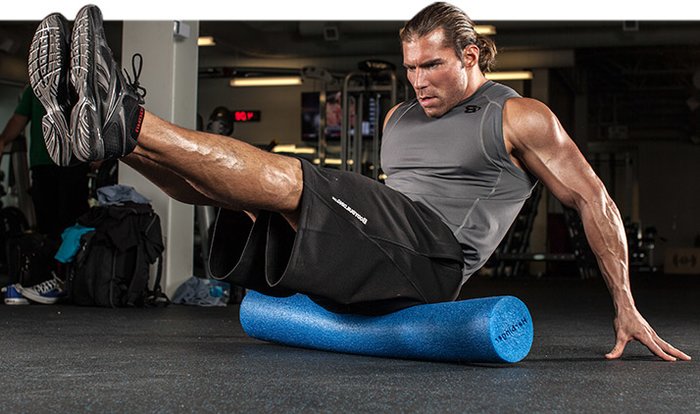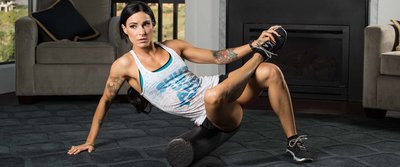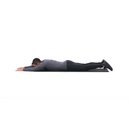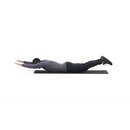For many people, delayed onset muscle soreness, or DOMS, is a sick pleasure that goes along with training. Sure, you can't sit, stand, go up or down the stairs, scratch your head, or put on a jacket, but hey, at least you earned it!
Outside of the weight room, however, DOMS is a more contentious topic. On one hand, many trainers object to the way people use it as the sign of an effective workout. On the other, researchers haven't fully agreed what produces it. One theory holds that the lactic acid release from intense training causes a shift in muscle pH, which subsequently dampens neural impulses in muscles and causes soreness during movement or compression. Another theory focuses on muscle micro-damage as the root cause of DOMS, as evidenced by distortions in muscle structure viewed under microscopes.
Whatever the anatomical root cause, it's relatively easy to predict when DOMS will occur. When I see trainees encounter new movements, heavy loads, or metabolic stressors like high volume and time under tension, DOMS is usually on the horizon.
Interestingly, high-level competitive athletes seem to be able to get to a point where they don't experience site-specific soreness even after intense two-a-day training. Unfortunately, the rest of us probably can't defeat DOMS completely.
But there's good news: Soreness can usually be controlled, if not exactly eliminated, with a few simple techniques. If some of them look familiar, it's because they're also well-known ways to boost your overall recovery—the most overlooked component of the training lifestyle. Here are my best solutions to avoid needing an "I've fallen and I can't get up" bracelet after your next hard workout.

{{caption}}
1. Foam Roll
Foam rolling has become a staple recovery technique in many people's fitness toolbox, and with good reason. In my experience, it does far more than basic stretching to assist with post-workout soreness. The compression and rolling of tissue stimulates fluid movement and healing processes to help improve the pliability of muscles. It hurts like hell, but it makes a big difference.
Foam rolling rules:
- Spend more time on tight areas.
- Go slow on tender spots.
- Remember to breathe.
2. Eat After Your Workout
Muscles require nutrients in order to recover. This may seem obvious, but it's often surprising how many people don't take it to heart. In many cases, soreness can be alleviated with protein-rich foods which minimize inflammation and digestive distress.
A simple rule is to consume a quality meal within 30-40 minutes of your workout, comprised of protein and slow-absorbing carbs. Follow this up a few hours later with substantial amounts of protein and fat a few hours later.
3. Take An Epsom Salt Bath
A hot bath is a fantastic way to loosen muscles post-workout. A hot bath with Epsom salts is even better, because the magnesium in the solution can be absorbed through the skin, helping reduce soreness and improve muscle function. The heat and buoyancy of water also speeds blood flow, which helps you relax and sleep soundly.
Epsom salt dissolves best with three quarters of a cup per tub of water. Swirl the water to make sure it's dissolved or you'll sit on granules. Cap the bath time at roughly 30 minutes. If you live in a warm climate, opt for cool water.
4. Sleep More
Sleep is the most overlooked aspect of training and recovery. Most average lifters—like average people—require 7-8 hours of sleep per night. However, hard-training strength athletes may require as much as 10 hours of sleep per night to see optimal recovery. But good luck finding many of them who actually get that much!
Checking your rested heart rate in the morning when you first wake is a good method to test recovery. A heart rate between 60-80 BPM is good, lower than that is awesome, and higher than that may indicate that you need more sleep.
Methods for better sleep:
- Work on deep and slow breathing.
- Shut off electronics an hour before bed.
- Take an Epsom salt bath.
5. Integrate Low-Intensity Cardio
These days anything less than full-intensity cardio gets looked upon with disdain, but the truth is that low-intensity, steady-state cardio can have a dramatic effect on muscle recovery. It may not get you as ripped as sprinting will, but it still offers a laundry list of benefits including increased blood flow, nutrient delivery, waste removal, lymphatic flow, and improved muscle function following hard and degenerative workouts. Low-intensity work can help dissipate soreness from strength training, increase range of motion, and wake up your nervous system to allow for better workouts later on.
Most people see the best benefits of low-intensity cardio by keeping their heart rate below 120 BPM. Keep these workouts to 30 minutes max in order to walk away fresh and not drained. In the gym, treadmills and bikes seem to provide the best benefits, but a brisk walk or hike outdoors is also a great option.

"Most people see the best benefits of low-intensity cardio by keeping their heart rate below 120 BPM."
6. Perform Active Recovery Workouts
A workout to recover from a workout? Sure! This "hair of the dog"-style recovery utilizes different movements, ranges of motion, and intensities than the movements that created soreness initially. Done correctly, it gives a great training effect without compounding soreness.
Effective active recovery training can include yoga, tai chi, Pilates, or something like what I've listed here. Go through the circuit without resting, but don't rush though the reps. When you complete the circuit, rest for two minutes and repeat one more time. This shouldn't take more than 15-20 minutes total.

"Effective active recovery training can include yoga, tai chi, or Pilates."

BodyFit
$6.99/month- 2,500+ expert-created single workouts
- 3,500+ how-to exercise videos
- Detailed workout instruction
- Step-by-step workout tips
- Training at gym or at home
- Access to Workout Plans
- Access to Bodyfit App
- Store Discounts
Already have a Bodybuilding.com account with BodyFit? Sign In

What comes with BodyFit?

- Instructional Videos
Don't risk doing a workout improperly! Avoid injury and keep your form in check with in-depth instructional videos.

- How-to Images
View our enormous library of workout photos and see exactly how each exercise should be done before you give it a shot.

- Step-by-Step Instructions
Quickly read through our step-by-step directions to ensure you're doing each workout correctly the first time, every time.




